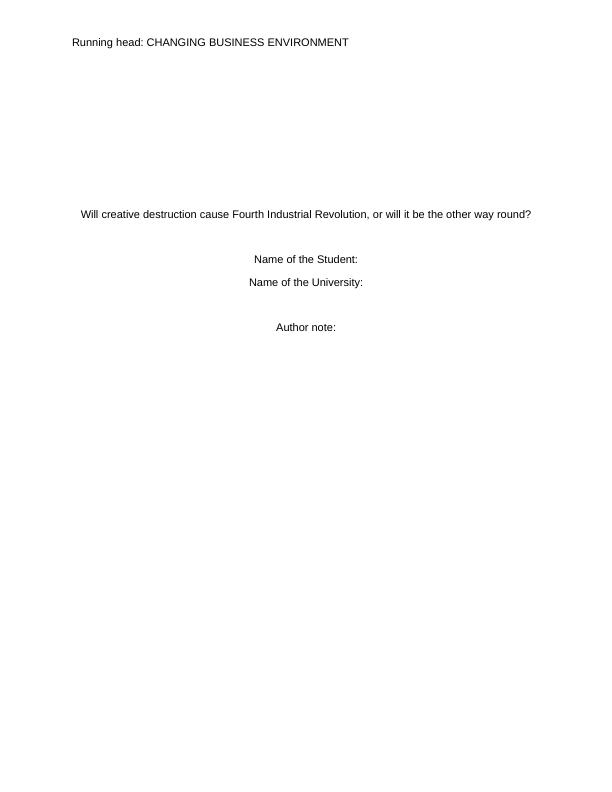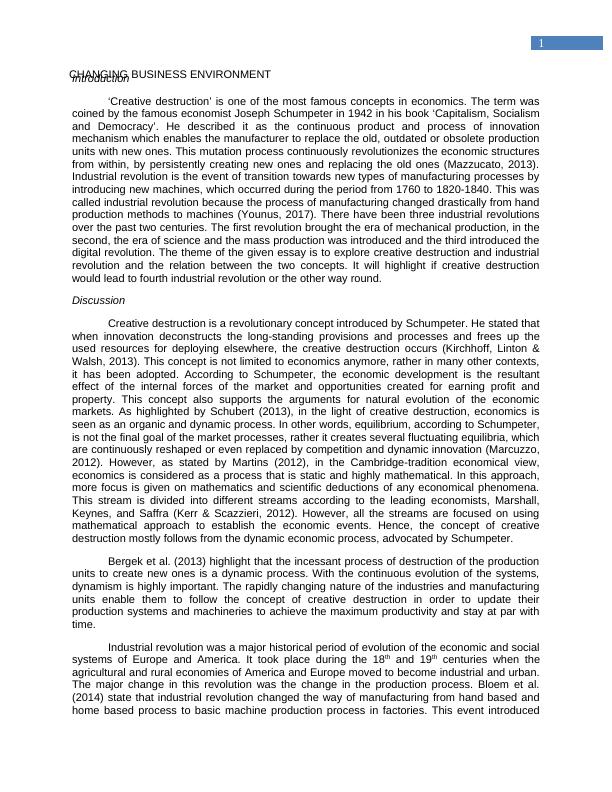Changing Business Environment
6 Pages2265 Words47 Views
Added on 2021-06-17
Changing Business Environment
Added on 2021-06-17
ShareRelated Documents
Running head: CHANGING BUSINESS ENVIRONMENTWill creative destruction cause Fourth Industrial Revolution, or will it be the other way round?Name of the Student:Name of the University:Author note:

1CHANGING BUSINESS ENVIRONMENTIntroduction‘Creative destruction’ is one of the most famous concepts in economics. The term wascoined by the famous economist Joseph Schumpeter in 1942 in his book ‘Capitalism, Socialismand Democracy’. He described it as the continuous product and process of innovationmechanism which enables the manufacturer to replace the old, outdated or obsolete productionunits with new ones. This mutation process continuously revolutionizes the economic structuresfrom within, by persistently creating new ones and replacing the old ones (Mazzucato, 2013).Industrial revolution is the event of transition towards new types of manufacturing processes byintroducing new machines, which occurred during the period from 1760 to 1820-1840. This wascalled industrial revolution because the process of manufacturing changed drastically from handproduction methods to machines (Younus, 2017). There have been three industrial revolutionsover the past two centuries. The first revolution brought the era of mechanical production, in thesecond, the era of science and the mass production was introduced and the third introduced thedigital revolution. The theme of the given essay is to explore creative destruction and industrialrevolution and the relation between the two concepts. It will highlight if creative destructionwould lead to fourth industrial revolution or the other way round. DiscussionCreative destruction is a revolutionary concept introduced by Schumpeter. He stated thatwhen innovation deconstructs the long-standing provisions and processes and frees up theused resources for deploying elsewhere, the creative destruction occurs (Kirchhoff, Linton &Walsh, 2013). This concept is not limited to economics anymore, rather in many other contexts,it has been adopted. According to Schumpeter, the economic development is the resultanteffect of the internal forces of the market and opportunities created for earning profit andproperty. This concept also supports the arguments for natural evolution of the economicmarkets. As highlighted by Schubert (2013), in the light of creative destruction, economics isseen as an organic and dynamic process. In other words, equilibrium, according to Schumpeter,is not the final goal of the market processes, rather it creates several fluctuating equilibria, whichare continuously reshaped or even replaced by competition and dynamic innovation (Marcuzzo,2012). However, as stated by Martins (2012), in the Cambridge-tradition economical view,economics is considered as a process that is static and highly mathematical. In this approach,more focus is given on mathematics and scientific deductions of any economical phenomena.This stream is divided into different streams according to the leading economists, Marshall,Keynes, and Saffra (Kerr & Scazzieri, 2012). However, all the streams are focused on usingmathematical approach to establish the economic events. Hence, the concept of creativedestruction mostly follows from the dynamic economic process, advocated by Schumpeter. Bergek et al. (2013) highlight that the incessant process of destruction of the productionunits to create new ones is a dynamic process. With the continuous evolution of the systems,dynamism is highly important. The rapidly changing nature of the industries and manufacturingunits enable them to follow the concept of creative destruction in order to update theirproduction systems and machineries to achieve the maximum productivity and stay at par withtime. Industrial revolution was a major historical period of evolution of the economic and socialsystems of Europe and America. It took place during the 18th and 19th centuries when theagricultural and rural economies of America and Europe moved to become industrial and urban.The major change in this revolution was the change in the production process. Bloem et al.(2014) state that industrial revolution changed the way of manufacturing from hand based andhome based process to basic machine production process in factories. This event introduced

2CHANGING BUSINESS ENVIRONMENTpowered and special-purpose machines, mass productions and factories. This has broughtrevolutionary change in people’s lives. The first industrial appeared around 1760 with theintroduction of steam engine. It introduced the age of mechanical production and steam wasused to power the machines (Hawken, Lovins & Lovins, 2013). In early 20th century, the secondrevolution happened when electric power was being used for mass production and science wasbeing developed in all aspects. In the third revolution, information technology and electronicsare used to automate the production process, and known as the digital revolution. This givesway for the fourth revolution, which is an extension of the third revolution (Kemp, 2016). Itpromotes a fusion of the digital technologies, with an aim to blur the lines between the physical,biological and digital spheres. () highlights that, today’s production system transformations are not a simpleprolongation of the third industrial revolution, rather it incorporates impact of velocity, systemsand scope into the revolutionary process. As compared to the earlier revolutions, the fourthrevolution is occurring at an exponential pace, rather than a linear pace. This is also bringingdisruptive innovations in all types of business, such as, the emergence of collaborativeeconomy, bought by Airbnb, Uber, Eatwith etc. Thus, not only in the production of tangiblegoods, but also in the service production, there is a revolution (Owyang, Tran & Silva, 2013). As in the matter of creative destruction, it aims to introduce the dynamic process ofproduction to replace the obsolete and outdated systems with newer technology to achievemaximum productivity, while, in case of fourth industrial revolution, the production systems arerapidly changing by incorporating the speed, scope, efficiency and maximum amount ofproductivity (Schwab, 2016). Hence, these two concepts are very close to each other. As highlighted by Raju (2016), creative destruction has its own upsides and downsidesin relation to the technologies, as well as economic repercussions. On one hand, creativedestructions introduces many new products and technologies which would be beneficial foreconomic expansion with more employment opportunities, while on the other hand, someindustries get eliminated due to automation technology. When the agricultural industry adoptednew automation technologies for increasing quality production, many unskilled and low skilledworkers lost their jobs. It is found that, almost 50-80% of the new products, developed throughcreative destruction, fail every year and not all the innovations have the same positive impact onthe society as well as on the environment (Schwab, 2016). Innovation does not end at theproduction level, but it should ensure that it takes care of the after effects of the consumption ofthe product or service. Hence, creative destruction involves technological innovation andinvention. In this regard, the fourth industrial revolution also revolves around the technologicalinnovation by incorporating digital reforms and automation. Both of these phenomena createvarious types of job opportunities due to technological innovation, while eliminate some. Themagnitude of job creation is much more than that of job abolition (Henton & Held, 2013). In thefourth industrial revolution, the impact on the jobs is related with the skill level of the workers.Due to enhanced digital automation, high skilled workers would be benefitted, however, the lowskilled workers can be vulnerable for losing the jobs. As argued by Peters (2017), the advent oflabor saving technology and automation process from the creative destruction has reducedemployment in many advanced countries. However, fourth industrial revolution has beenlaunching manufacturing process that is highly advanced and requires highly skilled knowledgeto run those. Hence, demand for high skilled workers increases compared to the low skilled orunskilled workers. Both the developed and developing economies are affected by this trend.

End of preview
Want to access all the pages? Upload your documents or become a member.
Related Documents
The changing business environment Assignment 2022lg...
|8
|2697
|15
Creative Destruction | Assignmentlg...
|5
|844
|132
Economics Assignment | Creative Destructionlg...
|9
|2841
|382
Innovation Management : Assignmentlg...
|12
|3712
|139
Business Information Modelling Assignment PDFlg...
|11
|3095
|287
Auditinglg...
|15
|3721
|318
